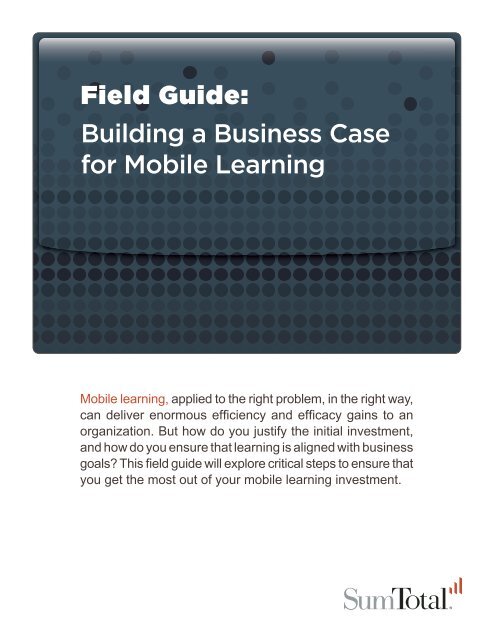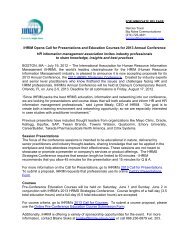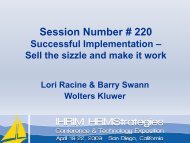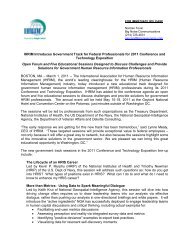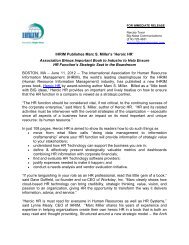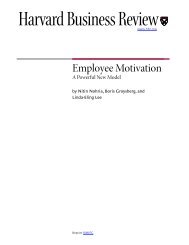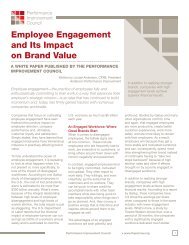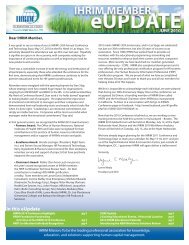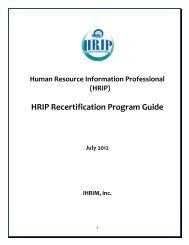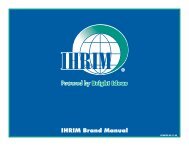SumT wp FieldGuide MobileLearning.pdf - IHRIM
SumT wp FieldGuide MobileLearning.pdf - IHRIM
SumT wp FieldGuide MobileLearning.pdf - IHRIM
Create successful ePaper yourself
Turn your PDF publications into a flip-book with our unique Google optimized e-Paper software.
Field Guide:<br />
Building a Business Case<br />
for Mobile Learning<br />
Mobile learning, applied to the right problem, in the right way,<br />
can deliver enormous effi ciency and effi cacy gains to an<br />
organization. But how do you justify the initial investment,<br />
and how do you ensure that learning is aligned with business<br />
goals? This field guide will explore critical steps to ensure that<br />
you get the most out of your mobile learning investment.
FIELD GUIDE: BUILDING A BUSINESS CASE<br />
FOR MOBILE LEARNING<br />
2<br />
Introduction<br />
Mobile learning, applied to the right problem, in<br />
the right way, can deliver enormous efficiency and<br />
efficacy gains to an organization. But how do you<br />
justify the initial investment, and how do you ensure<br />
that learning is aligned with business goals?<br />
This document looks at mobile learning from a<br />
business manager’s perspective and describes some<br />
of the ways it can improve your bottom line and build<br />
a compelling business case for the adoption and<br />
implementation of e-learning in your organization.<br />
THE BUSINESS ADVANTAGES OF MOBILE LEARNING<br />
Traditional instructor-led classroom-based training or virtual trainings delivered<br />
via computer-based learning management systems (LMS) are still effective ways<br />
to teach new skills. But it comes at a high cost in terms of time commitment.<br />
Classroom training requires travel and loss of work time while computer-based<br />
training requires the employee to remain fi xed at a work station, and classroom<br />
instruction is generally during working hours. This means employees can spend<br />
several working days on training just to achieve compliance in some cases.<br />
Mobile breaks these chains to allow for “untethered” learning at the time when<br />
it is most necessary or most convenient – on or off the clock. The very nature<br />
of how people use mobile devices tells us that the device is always on, always<br />
in-hand and always connected. An employee can have access to the information<br />
he or she needs to do the job anytime, anywhere, even without Internet access<br />
because of the explosion of smartphones and tablets on the market.<br />
Mobile learning, when married with an LMS, can offer organizations and individuals<br />
the following key benefits:<br />
■ Increase training opportunities as learners access content in the<br />
moment<br />
■ Easy access and acquisition of all the information within the LMS
FIELD GUIDE: BUILDING A BUSINESS CASE<br />
FOR MOBILE LEARNING<br />
3<br />
■ Ability to provide learning via mobile devices to employees without<br />
computer infrastructure<br />
■ Organization can leverage SCORM authoring tools to build<br />
compelling mobile content<br />
■ End users can engage in a completely offl ine learning experience<br />
that includes rich media and video without risking poor quality<br />
from bad connections<br />
■ Track completions, scores and overall impacting using the native<br />
reporting capabilities<br />
The growth in mobile-delivered learning is driven by rapid user adoption, signifi cant<br />
cost savings, more effective presentation of training content, reinforcement of<br />
on-the-job performance and the immediate availability of access to job aids<br />
and resources. Whereas employees once had to congregate in one location or<br />
remain seated in front of a computer to receive corporate learning, corporate<br />
learning can now come to them. Employees can pull out bit-sized training when it<br />
is needed, making the value, potential and return on the invest increase because<br />
the learner will learn more when the information is relevant to him or her.<br />
Convincing your senior management team to implement a mobile learning system<br />
will require a clearly defi ned business case. Developing a laundry list of potential<br />
benefi ts is only the beginning; you must then apply them to your particular<br />
business situation. A business case will offer a clear statement of the business<br />
problem(s) and your proposed solution(s), as well as provide measurements of<br />
success. In essence, it describes your organization’s current status versus the<br />
desired status, and how the organization can achieve its goals.<br />
ALIGNING MOBILE LEARNING WITH BUSINESS GOALS AND<br />
MEASURING RESULTS<br />
The target audience for your mobile learning business case will most likely<br />
be both business unit managers and senior executives—the people who will<br />
ultimately give your proposal the business and fi nancial support it needs to<br />
succeed. Consequently, it is important that your business case be aligned with<br />
their business goals and “pain points.”<br />
Business Unit Managers<br />
Business unit managers own the problems that training solves. They are<br />
pragmatic; their overriding interest is getting the job done—and soon. Until you<br />
know what your business unit managers are trying to accomplish, you can’t talk<br />
to them about potential results.
FIELD GUIDE: BUILDING A BUSINESS CASE<br />
FOR MOBILE LEARNING<br />
4<br />
The business unit manager is usually training’s primary sponsor. The “right client”<br />
is the decision-maker who understands the end goal and has responsibility for<br />
the organizational area in which the problem occurs. When you’re working with<br />
the right client in your organization, measuring results is not diffi cult. Start with<br />
the business unit manager’s business problems and work backwards. The most<br />
important step in measuring performance is to pin down the business manager’s<br />
answer to the classic question: “What’s in it for me?”<br />
Don’t skip this step. Without it, meaningful tracking is impossible. First, gain<br />
agreement on the business problem(s) to be solved and the value of solving<br />
it (them). Then go on to outline your proposed solutions. Establish a baseline<br />
measure of current performance and clearly indicate how performance will be<br />
tracked and reported.<br />
Determine what your project sponsor(s) will accept as persuasive evidence that<br />
the program produced the agreed upon result, then make your case logically by<br />
linking learning to business results. Establish a causal (not casual!) link between<br />
a particular skill defi ciency and a particular business outcome. Build a compelling<br />
logical argument based on the business unit manager’s metrics, performance<br />
requirements and the metrics that would indicate the return on the mobile learning<br />
investment. The process of tracking learning results starts before any learning<br />
takes place. It begins with an agreement between the training manager and the<br />
line manager on the value of solving the problem.<br />
Your joint examination of the problem will clarify the gap between the results<br />
desired and the results you’re actually getting. Then determine what major<br />
skill gaps and learning defi ciencies are holding people back and estimate the<br />
expected dollar value to be gained by eliminating the defi ciency. Again, make<br />
sure you get agreement on the expected outcomes, how they will be measured<br />
and what constitutes good performance.
FIELD GUIDE: BUILDING A BUSINESS CASE<br />
FOR MOBILE LEARNING<br />
5<br />
Throughout the process, help the managers answer questions about why skills<br />
matter and what on-going good performance looks like. You are focusing sustained<br />
attention on solving business problems and adding and identifying tangible<br />
values for each skill to be taught. As a result, you’re forging a partnership with<br />
the business unit manager based on the core concern: maximizing performance<br />
without taking the employee away from the job.<br />
Senior Executives<br />
No organization has the resources to do everything it might want. Senior executives<br />
are forced to choose where the company’s top priorities lie, what comes first,<br />
whether initiatives should be completed in-house or outsourced, and which will<br />
yield the greatest return. A good business case shows expected consequences<br />
of the action over time, and, most importantly, includes the methods and rationale<br />
used to quantify benefits and costs.<br />
Executives focus on two things: strategy and outfoxing the competition.<br />
Consequently, they will be interested most in information that discusses sales,<br />
revenues and profi ts, as well as what will increase the company’s market share.<br />
Consequently, they are looking for you to convince them that your mobile learning<br />
initiative is worthy of the organization’s time, effort and money. To make their<br />
analysis clear, distill a complex business alternative into a three- or four-page<br />
business case to provide a tool that supports planning and decision making,<br />
including information about which vendor to choose and when to implement.<br />
From a senior executive’s standpoint, business cases are generally designed to<br />
answer the question: What are the likely fi nancial and other business consequences<br />
if we take (or don’t take) this or that action? Creating a business case that is deeply<br />
ingrained with the insights of the business unit manager will help you in labeling<br />
that person as a trusted advocate for the senior executive to consult with further.<br />
RETURN ON INVESTMENT FROM MOBILE LEARNING<br />
Your CFO and/or executive team has probably already asked you to justify your<br />
training investment in terms of fi nancial payback. Being able to produce an<br />
accurate and defendable return on investment (ROI) has long been the holy grail<br />
of the training industry. Much has been written on the topic, but in the end, every<br />
calculation has some element of subjectivity.<br />
However, there is still a lot you can talk to your executive team about to justify<br />
the mobile learning investment. Financial calculations can be based on the<br />
reduction in time taken to complete tasks, the ability to carry out activities not<br />
possible before, or increases in the quality of activities. Here you can refi ne your
FIELD GUIDE: BUILDING A BUSINESS CASE<br />
FOR MOBILE LEARNING<br />
6<br />
persuasive appeal for the desire of every executive: mobile learning will increase<br />
the company’s speed to money.<br />
Turning to the cost side of the equation, mobile learning offers several advantages<br />
over other types of training. You need to take into account the following factors:<br />
■ The productivity lost from being away from the job is likely to be<br />
considerably lower, particularly if employees are willing to train<br />
outside normal work hours.<br />
■ The training time may also be less, given the ability to take<br />
just the required training modules (or “opting out” by showing<br />
competency in a pre-test) rather than having to attend an entire<br />
course. This decreases employee time-to-productivity/time-toproductivity<br />
or competency.<br />
■ Mobile learning requires very little to no training administration<br />
for student course bookings, reserving classrooms or updating<br />
training records.<br />
■ Course creation to maintain new compliance rules or inform on<br />
new product offerings is easier when courses are shorter. Mobile<br />
learning offers the benefits of rapid content development because<br />
the courses are naturally shorter, which can prove effective in<br />
engaging and satisfying employees needs in a timely manner.<br />
■ Mobile learning also delivers a number of less tangible<br />
organizational benefi ts:<br />
■ By empowering individuals to develop their own skills<br />
when they want, enhanced employee motivation<br />
and reduced staff attrition will lead to savings in<br />
recruitment costs.<br />
■ Mobile learning can offer a higher knowledge<br />
retention rate as information is accessed when it is<br />
needed and archived for reference later.<br />
■<br />
Mobile learners can use their own “native” devices.<br />
In the next section of this document, we’ll look at two specific ways of using mobile<br />
learning that offers substantial benefi ts:<br />
■ The ability to develop, introduce and roll-out internal product<br />
or customer training quickly and on a nationwide or worldwide<br />
scale, leading to faster time to market, earlier revenue streams<br />
and enhanced competitiveness.
FIELD GUIDE: BUILDING A BUSINESS CASE<br />
FOR MOBILE LEARNING<br />
7<br />
■ The possibility of providing training directly to your customers<br />
much more easily, leading to new revenue streams or enhanced<br />
product adoption.<br />
■ Provide easy access to technical support documents that are<br />
frequently updated.<br />
Clearly, not all of these paybacks can or will be achieved overnight. However,<br />
these represent a realistic set of quantifi able benefi ts to help build your business<br />
case for e-learning.<br />
MOBILE LEARNING FOR RAPID PRODUCT ROLL-OUT<br />
Introducing new products, systems or processes to your employees and<br />
salespeople via classroom training can be a major project. Apart from the high<br />
cost, such projects can also take substantial time to develop and deliver; thereby<br />
delaying the date when the new offi ce system can be brought online or the new<br />
product can be offered to customers.<br />
But the old barriers of time and distance can be eroded signifi cantly using mobile<br />
learning technology. Once the training has been created and made available<br />
via a learning management system, it is also automatically available to all<br />
employees via mobile learning. Any number of individuals can take the course<br />
simultaneously—even within a required time period—and you’ll know when<br />
they’ve completed the material and demonstrated profi ciency by achieving, for<br />
instance, a passing score on a post-test.<br />
Mobile learning is particularly benefi cial to an organization operating in a<br />
marketplace where there is constant change. For example, a company with a<br />
large product offering faces an enormous struggle in keeping its sales force upto-date<br />
and educated, especially if that sales force is geographically dispersed.<br />
But mobile enables product development and sales training departments to<br />
create and deliver training quickly and without regard to distance.<br />
Mobile learning is also the best resource for just-in-time training; for example,<br />
as a refresher or knowledge database that can be accessed just before making<br />
a sales call. A sales representative could be out to a client’s offi ce on the day a<br />
new product training becomes available. Somewhere between lunch and their<br />
afternoon meeting, the representative could take the mobile course and have a<br />
whole new sales pitch for the client. And your company can update this mobile<br />
learning material and make it quickly available to employees you want to turn<br />
downtime in the grocery line, waiting for their children to fi nish piano lessons or<br />
stuck in a traffi c jam into uptime.
FIELD GUIDE: BUILDING A BUSINESS CASE<br />
FOR MOBILE LEARNING<br />
8<br />
If you already have your mobile infrastructure and culture in place, then new<br />
product rollouts quickly become a matter of creating the training material and<br />
making it available online. In summary, consider the following benefi ts:<br />
Further, the mobile training method can also be extended to customers, strategic<br />
partners and third-party vendors to deliver valuable training that informs on your<br />
products and services while also providing another potential stream of income,<br />
along with cost and time savings and a decreased time-to-market. Mobile learning<br />
with your extended enterprise will often garner better training completion results<br />
as these individuals will be even less inclined than your own employees to sit for<br />
prolonged periods in classrooms or in front of computers that can create some<br />
highly unproductive working days.<br />
Of course, there are many other benefi ts from having more knowledgeable<br />
customers and channel partners, including higher brand loyalty and fewer<br />
service calls. And it can often be advantageous to provide the training for free—<br />
particularly if it relates to the sales process. For example, potential buyers can<br />
take a mobile tour of your company’s products and the available options, guiding<br />
them through the purchase decision with advice, comparison reviews and<br />
fi nancial planning tools. In the end, you’ll deliver an increased number of wellqualifi<br />
ed and educated customers to your sales department.
FIELD GUIDE: BUILDING A BUSINESS CASE<br />
FOR MOBILE LEARNING<br />
9<br />
MOVING YOUR MOBILE BUSINESS CASE FORWARD<br />
This document has described several different aspects of building a business case<br />
for mobile learning in your organization. Building a strong case means justifying<br />
the initial investment and aligning mobile learning with your organization’s<br />
business goals. Doing so will help you win the necessary fi nancial and business<br />
support of your business unit managers and senior executives.<br />
<strong>SumT</strong>otal Mobile<br />
According to the Bersin & Associates 2011 research report, “m-Learning<br />
Update,” mobile learning itself is not revolutionary, and the content delivered is<br />
not necessarily new. Mobile learning’s power comes from its ability to connect<br />
employees to the knowledge and expertise they need when and where they<br />
need it, making it useful for potentially almost any learning need.<br />
Because mobile learning has a strong basis in the content and administration<br />
of e-learning, one vendor you should consider including in your business case<br />
for mobile learning is <strong>SumT</strong>otal Systems. Already known as a leader in Learning<br />
Management, without which no mobile solution can effectively operate, the<br />
company offers <strong>SumT</strong>otal Mobile, drawing upon its vast industry knowledge and<br />
innovative spirit. <strong>SumT</strong>otal Mobile provides users the following key features:
FIELD GUIDE: BUILDING A BUSINESS CASE<br />
FOR MOBILE LEARNING<br />
10<br />
BUSINESS CASE TEMPLATE<br />
The following provides a breakdown or template of the basic elements you need<br />
to cover to develop your own e-learning business case.<br />
Problem Statement<br />
Clearly state the specifi c business problem(s) to be addressed.<br />
Background<br />
Include signifi cant information regarding skills, knowledge, budgeting and<br />
performance that contribute to the business problem. Indicate in general terms<br />
what’s required to resolve or alleviate the business problem(s).<br />
Proposed Solution<br />
Outline the proposed solution.<br />
Project Objectives<br />
State what the proposed solution is trying to accomplish.<br />
Current Process<br />
Identify the organizational processes that the proposed solution will affect,<br />
including internal departments, clients, external partners, vendors and the<br />
competition.<br />
Requirements<br />
List the resources needed to complete the project (staff, hardware, software,<br />
time, budget, etc.)<br />
Alternatives<br />
Describe other options to implementing the proposed solution. Be sure to include<br />
basic requirements for each and estimate project risks, ramp-up time, costs and<br />
project delays.<br />
Compare Alternatives & State Advantages<br />
Compare and contrast each of the alternatives with the proposed solution. State<br />
similarities and differences, benefi ts and detriments, and costs associated with<br />
each option.<br />
Summarize the advantages of your proposed solution, paying particular attention<br />
to such items as ROI and cost/benefi t analysis, as well as the impact on revenues,<br />
profi ts and expenses.
FIELD GUIDE: BUILDING A BUSINESS CASE<br />
FOR MOBILE LEARNING<br />
11<br />
Additional Considerations<br />
List critical success factors other than metrics; for example, effects on partnership<br />
agreements with specifi c vendors, internal marketing and promotion, and the<br />
potential need for help desk or customer support.<br />
Action Plan/Recommendation<br />
Propose specifi c action steps. State your short-term and long-term action plans,<br />
including major milestones.<br />
Success Measurements<br />
Outline how you will measure the solution’s overall success (tie directly to Project<br />
Objectives).<br />
Executive Summary<br />
Compose a single page that will provide a clear, concise summary of the<br />
proposed solution. Include a high-level overview of your research that leads you<br />
to the proposal.
FIELD GUIDE: BUILDING A BUSINESS CASE<br />
FOR MOBILE LEARNING<br />
12<br />
MORE INFORMATION<br />
For additional information, send an email to<br />
connect@sumtotalsystems.com<br />
ABOUT SUMTOTAL<br />
<strong>SumT</strong>otal Systems, Inc. is the global leader in strategic Human<br />
Capital Management (HCM) solutions that provide organizations<br />
with a new level of visibility to help make more informed business<br />
decisions and accelerate growth. Recognized by industry<br />
analysts as the most complete solution, <strong>SumT</strong>otal provides full<br />
employee lifecycle management, including a core system of<br />
record, from a single provider for improved business intelligence.<br />
The company offers customers of all sizes and industries the most<br />
flexibility and choice with multiple purchase, configuration, and<br />
deployment options. We have increased the performance of the<br />
world’s largest organizations including Sony Electronics (NYSE:<br />
SNE), AstraZeneca (NYSE: AZN [ADR]; London: AZN), Amway<br />
(KUL:AMWAY), Seagate (NYSE: STX), Dell (NASDAQ:DELL),<br />
and Google (NASDAQ:GOOG).<br />
For more information, or to request a demo, please call +1 (866)<br />
768-6825 (US / Canada), +1 (352) 264-2800 (international) or<br />
visit www.sumtotalsystems.com<br />
CORPORATE HEADQUARTERS:<br />
SUMTOTAL SYSTEMS, INC.<br />
2850 NW 43RD STREET<br />
SUITE #150<br />
GAINESVILLE, FL 32606 USA<br />
PHONE: +1 352 264 2800<br />
FAX: +1 352 264 2801<br />
EMEA:<br />
SUMTOTAL SYSTEMS, UK<br />
59-60 THAMES STREET<br />
WINDSOR, BERKSHIRE<br />
UNITED KINGDOM, SL4 1TX<br />
PHONE +44 (0) 1753 211 900<br />
FAX +44 (0) 1753 211 901<br />
APAC:<br />
SUMTOTAL SYSTEMS, INDIA PVT. LTD.<br />
7TH FLOOR MAXIMUS TOWERS<br />
BUILDING 2B, MIND SPACE<br />
RAHEJA IT PARK, CYBERABAD<br />
HYDERABAD, AP- 500081, INDIA<br />
PHONE: +91 (0) 40 6695 0000<br />
FAX: +91 (0) 40 2311 2727<br />
© 2012 <strong>SumT</strong>otal Systems, Inc. All rights reserved. <strong>SumT</strong>otal,<br />
the <strong>SumT</strong>otal logo, and ToolBook are registered trademarks<br />
or trademarks of <strong>SumT</strong>otal Systems, Inc. and/or its affiliates in<br />
the United States and/or other countries. Other names may be<br />
trademarks of their respective owners. 012_0322LS


